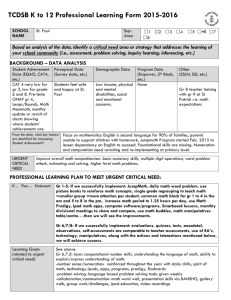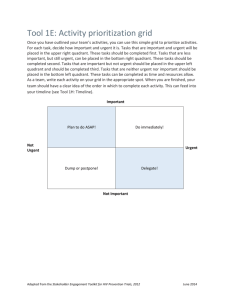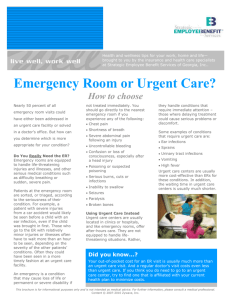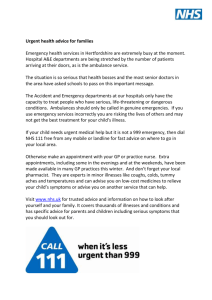Urgent Safety Measures - UK Trial Managers` Network (TMN)
advertisement
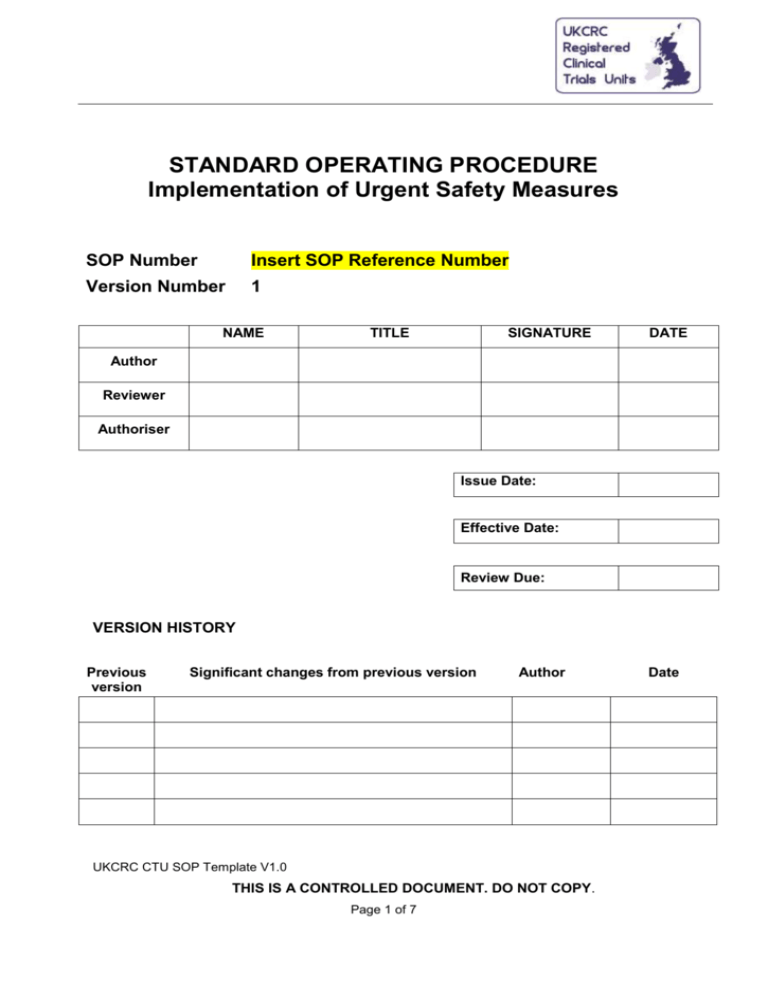
STANDARD OPERATING PROCEDURE Implementation of Urgent Safety Measures SOP Number Insert SOP Reference Number Version Number 1 NAME TITLE SIGNATURE DATE Author Reviewer Authoriser Issue Date: Effective Date: Review Due: VERSION HISTORY Previous version Significant changes from previous version Author UKCRC CTU SOP Template V1.0 THIS IS A CONTROLLED DOCUMENT. DO NOT COPY. Page 1 of 7 Date SOP Title: Implementation of Urgent Safety Measures SOP No: SOP Version: Effective: 1. PURPOSE In compliance with the EU Clinical Trials Directive1 (transposed into UK law as the Medicines for Human Use (Clinical Trials) Regulations 2004 No.10312, as amended) and Research Governance Framework (2nd edition)3, procedures for the implementation of urgent safety measures are required for clinical trials involving human participants. This Standard Operating Procedure (SOP) describes the procedures to be followed when it is necessary to implement urgent safety measures. 2. SCOPE This SOP applies when there is a need to address an urgent safety issue relating to the conduct of clinical trials involving human participants. This SOP applies to clinical trials of investigational medicinal products (CTIMP) as well as non-CTIMPs. 3. INTRODUCTION The conduct of clinical research is subject to a regulatory and ethical framework to ensure the protection of the rights, safety and wellbeing of trial participants and the credibility of the trial data. Any changes made to the conduct of a clinical trial after a favorable ethical opinion or approval by a regulatory body has been given are termed ‘amendments’. Amendments can be made to a protocol, other essential documentation or other aspects of a study’s arrangements. An amendment to a research project can be either substantial or minor (non-substantial) in nature. Substantial amendments require a favorable opinion from the MREC and/or MHRA before they can be implemented. The only exception to this is where urgent safety measures need to be taken. An urgent safety measure is a procedure which is not defined by the protocol that can be put in place with immediate effect without needing to gain prior authorisation by the REC (and MHRA where applicable), in order to protect clinical trial participants from any immediate hazard to their health and safety. For CTIMPs examples of urgent safety issues may include the occurrence of a single case report of a Serious Adverse Reaction (SAR) that has an unexpected outcome, or a clinically important SAR occurring with greater frequency than anticipated or a significant hazard, such as lack of efficacy with an IMP used to treat a life-threatening disease4. An example of an urgent safety issue that may occur in either CTIMP and non-CTIMPs would be one happening as a result of trial procedures, rather than as a result of an intervention being investigated, for example it may be identified that a trial related assessment exposes participants to unforeseen risk requiring an urgent amendment of trial conduct. 4. ABBREVIATIONS 4.1 Acronyms and abbreviations CTIMP Clinical trials of investigational medicinal products UKCRC CTU SOP Template V1.0 THIS IS A CONTROLLED DOCUMENT. DO NOT COPY. Page 2 of 7 SOP Title: Implementation of Urgent Safety Measures SOP No: SOP Version: Effective: Non-CTIMP Clinical trials assessing interventions investigational medicinal products REC Research Ethics Committee 4.2 Definitions Add definitions to SOP as needed locally. 5. RESPONSIBILITIES other than SI 2004/1031 part 4 30 requires that the Sponsor of a clinical trial ensures there are arrangements for implementing appropriate urgent safety measures to protect participants against any immediate hazard. In practice, the individual best able to take these measures will be the CI, or another identified person or organisation, rather than the Sponsor directly. If the decision making process is to include the trial independent oversight committee/s (Trial Steering Committee or Data Monitoring Committee) this should be identified at the outset and documented accordingly. Unless the CTU has documentation in place, for example signed authority from the Sponsor, acknowledging who retains the responsibility for taking these actions (usually this individual will be the CI in partnership with the CTU), the Sponsor remains directly responsible. Reports will generally be channelled via designated CTU personnel, usually this will be the trial coordinator. All members of the research team are responsible for reporting (to the sponsor or delegated party) if they believe that the implementation of safety measures is required. CTU personnel identified on the delegation/signature log (amend or add reference to local procedure) to be responsible for site training, usually this will be the designated trial coordinator (add reference to relevant SOP), should ensure instructions for reporting of potential urgent safety issues are included during site initiation training (add reference relevant SOP). 6. PROCEDURE During the development of the trial protocol, the trial management group (add reference to local trial oversight committee composition/roles) should ensure that the responsibilities for decision making and implementing of urgent safety measures are both clearly defined and appropriately recorded in contracts and/or site delegation logs (add reference to local SOPs/procedures). Training in regard to reporting requirements should be included during site initiation visits. 6.1 Urgent Safety Measures - CTIMP The following procedure should be followed if a designated CTU staff member, usually the trial coordinator, becomes aware of information that indicates an immediate change in a trial procedure, or a temporary halt to a trial may be necessary in order to protect clinical trial participants from any immediate hazard to their health and safety: 1. The designated CTU staff member should immediately record the details of the incident on an incident report form (suggested template as TEMPLATE_01_urgent safety measure_decision or add reference to units own). They should then inform the CI, Sponsor (via their designated representative), and/or other designated individual (such as nominated senior CTU personnel, who has been delegated the responsibility for decision making with regard to urgent safety measures), with full details of the information they have received relating to the incident. UKCRC CTU SOP Template V1.0 THIS IS A CONTROLLED DOCUMENT. DO NOT COPY. Page 3 of 7 SOP Title: Implementation of Urgent Safety Measures SOP No: SOP Version: Effective: 2. The individual designated to make a decision about implementing safety measures considers whether urgent safety measures are necessary to protect participants against any immediate hazard. 3. If trial participants are at risk, the designated individual should inform the CTU that urgent safety measures are to be implemented so that proposed actions can be agreed. 4. The decision making process leading to the implementation of the urgent safety measures are documented (suggested template as TEMPLATE_01_urgent safety measure_decision or add reference to units own). 5. For CTIMPs, the sponsor or another delegated individual should phone the Clinical Trial Unit at the MHRA and discuss the issue with a medical assessor immediately (i.e. within 24 hours). In practice this will ideally be done in parallel to identifying the necessary corrective and preventative measures required and discussions with the medical assessor may inform these actions. 6. The details of the medical assessor spoken to and a summary relating to the outcome of their conversation must be recorded (suggested template as TEMPLATE_01_urgent safety measure_decision or add reference to units own). 7. For both CTIMP and non-CTIMPs verbal notification, via telephone, should also be provided to the main Research Ethics Committee and the outcome of these discussions should be summarised (suggested template as TEMPLATE_01_urgent safety measure_decision or add reference to units own). 8. The requirement to initiate an urgent safety measure, and the proposed corrective/preventative action, should be communicated to all sites immediately (i.e. within 24 hours of the decision) with acknowledgment of its receipt and implementation received from each Principal Investigator. 9. The implemented urgent safety measures (e.g. amendment to protocol, temporary halt to the trial or premature closure of the trial) must be reported in writing to the MHRA and Ethics Committee within 3 days. Note that The Medicines for Human Use (Miscellaneous Amendments) Regulations 2009 allows that urgent safety measures implemented during a pandemic may be informed in writing “as soon as possible” rather than within the otherwise required 3 day period. 10. For CTIMP, the MHRA are notified; the substantial amendment should include a covering letter detailing the measures taken, the reason for the measures taken, details of the medical assessor contacted; a Notification of Amendment form; and supporting documentation. The MHRA Clinical Trials Unit on 020 7084 2443 or sent by e-mail to clintrialhelpline@mhra.gsi.gov.uk). The amendment should be marked ‘Urgent Safety Measure’. The amendment should also be sent as PDF documents on a disk to: Clinical Trials Unit 3T, MHRA 151 Buckingham Palace Road Victoria SW1W 9SZ (These contact details are taken from the MHRA website6, and should be checked when the implementation of urgent safety measures is considered to be necessary 11. If delegated to the CTU to do so, the completion and submission of the substantial amendment form should be arranged by the designated trial coordinator. 12. For CTIMP and non-CTIMP the main REC are notified; Notice in writing should be sent within 3 days7 and this will be reviewed at a meeting of the main REC or subcommittee. The main REC do not require this notice to be accompanied by a UKCRC CTU SOP Template V1.0 THIS IS A CONTROLLED DOCUMENT. DO NOT COPY. Page 4 of 7 SOP Title: Implementation of Urgent Safety Measures SOP No: SOP Version: Effective: substantial amendment form, however it should describe corrective and preventative actions, such as intention to submit substantial amendment to protocol, temporary halt of the trial etc. For best practice, notice of the substantial amendment should be submitted within 3 days: a. For CTIMPs the notice of substantial amendments must use the European Commission form, available on the EudraCT: European Clinical Trials website8. The form should be signed by the named applicant and a single hard copy of the relevant form should be submitted to the REC, together with all relevant enclosures. b. For all other research, the NRES Notice of Substantial Amendment9, form should be used. The completed Notice of Substantial Amendment form should be either signed in ink by the Chief Investigator or authorised using electronic authorisation via the Integrated Research Application System (IRAS; Access to the form is enabled in IRAS when the submission history for the REC form shows there is a completed version of the initial application). A single hard copy of the form should be submitted to the REC, together with all relevant enclosures. 13. For CTIMP and non-CTIMP, NHS R&D should be notified; Principal investigators, or other delegated individual/s, will be supplied with a copy of the appropriate substantial amendment form for submission to R&D departments in parallel to the ethical and regulatory notifications. 14. Arrangements for contacting the individual responsible for decision making with regard to urgent safety measures during extended breaks (for example Christmas and Easter) should be made to ensure appropriate cover is in place. 15. To recommence a temporarily halted trial, the CTU (via the trial coordinator), if delegated to do so, should make the request as a substantial amendment using the notification of amendment form and providing evidence that it is safe to restart the trial. 16. If a sponsor decides not to recommence a temporarily halted trial, the MHRA and Ethics Committee should be notified within 15 days of this decision, using the End of Trial Declaration form available from the EudraCT: European Clinical Trials website8 and including a brief explanation of the reasons for ending the trial. This will be undertaken by the CTU, if it is delegated to do so. 6.2 Urgent Safety Measures – non-CTIMP Projects that do not involve an IMP do not require authorisation by the MHRA however appropriate governance arrangements are still required. Should urgent safety measures be necessitated in a non-CTIMP project, all of the steps detailed in 6.1.1 should be followed, other than communication with, and notification of, the MHRA. In addition, for medical devices there should be appropriate vigilance reporting and if it is a clinical investigation of non-CE marked medical devices, MHRA (Medical devices)10 should be notified (add reference to relevant SOP). 7. SUPPORTING DOCUMENTS Number Title TEMPLATE01 TEMPLATE_01_urgent safety measure_decision UKCRC CTU SOP Template V1.0 THIS IS A CONTROLLED DOCUMENT. DO NOT COPY. Page 5 of 7 SOP Title: Implementation of Urgent Safety Measures SOP No: SOP Version: Effective: 8. REFERENCES 1. Directive 2001/20/EC of the European Parliament and of the Council of 4 April 2001 on the approximation of the laws, regulations and administrative provisions of the Member States relating to the implementation of good clinical practice in the conduct of clinical trials on medicinal products for human use: http://eurlex.europa.eu/LexUriServ/LexUriServ.do?uri=CELEX:32001L0020:EN:HTML (accessed 04 January 2011) 2. Statutory Instrument 2004 No. 1031 The Medicines for Human Use (Clinical Trials) Regulations 2004: http://www.opsi.gov.uk/si/si2004/20041031.htm (accessed 04 January 2011) 3. Research Governance Framework for Health and Social Care: Second edition: http://www.dh.gov.uk/en/Publicationsandstatistics/Publications/PublicationsPo licyAndGuidance/DH_4108962 (accessed 04 January 2011) 4. International Conference Harmonised Tripartite Guideline: Clinical Safety Data Management: Definitions and Standards for Expedited Reporting E2A (October 1994) (accessed 04 January 2011) 5. The Medicines for Human Use (Miscellaneous Amendments) Regulations 2009 (accessed 04 January 2011) 6. Medicines and Healthcare products Regulatory Agency http://www.mhra.gov.uk/Howweregulate/Medicines/Licensingofmedicines/Clini caltrials/Safetyreporting-SUSARsandASRs/index.htm#10 (accessed 04 January 2011) 7. National Research Ethics Service Standard Operating Procedures for Research Ethics Committees version 4.1 (May 2010) (accessed 04 January 2011) 8. EudraCT: European Clinical Trials website https://eudract.emea.europa.eu/ (accessed 04 January 2011) 9. National Research Ethics Service notice of substantial amendments documentation for CTIMPs and non-CTIMPS (accessed 04 January 2011) 10. MHRA (Medical devices) http://www.mhra.gov.uk/Howweregulate/Devices/Clinicaltrials/index.htm (accessed 04 January 2011) 9. APPENDICES UKCRC CTU SOP Template V1.0 THIS IS A CONTROLLED DOCUMENT. DO NOT COPY. Page 6 of 7 SOP Title: Implementation of Urgent Safety Measures SOP No: SOP Version: Effective: 9.1 Process Flowchart Designated staff member becomes aware that immediate change in trial procedure/ temporary halt may be required and immediately submits report/s to designated decision maker Urgent Safety Measure required? Report and associated documents filed in TMF (No further corrective action required) No Yes CTIMP non-CTIMP Within 24 hours of decision: 1. Verbal notification made to MHRA and MREC and outcome of discussions documented 2. Corrective and preventative measures identified 3. All sites notified (PI and other staff as appropriate and R&D) 4. Confirmation of implementation of urgent safety measures received from all PIs Substantial amendment required? Within 24 hours of decision: 1. Verbal notification made to MREC and outcome of discussions documented 2. Corrective and preventative measures identified 3. All sites notified (PI and other staff as appropriate and R&D) 4. Confirmation of implementation of urgent safety measures received from all PIs No (unlikely if urgent safety measures are deemed necessary) Substantial amendment required? Yes Yes Within 3 days of decision*: 1. Written notification of implementation of urgent safety measures submitted to MHRA and MREC comprising: (i) Covering letter (ii) Notification of Substantial Amendment form (European Commission form) (iii) Any relevant supporting document/s 2. Copy of Notification of Substantial Amendment form provided to PIs for submission to R&D Within 3 days of decision: Written notification of implementation of urgent safety measures submitted to MHRA (if applicable) and MREC comprising: (i) Covering letter (ii) Any relevant supporting document/s Within 3 days of decision: 1. Written notification of implementation of urgent safety measures submitted to MREC comprising: (i) Covering letter (ii) NRES Notification of Substantial Amendment form (iii) Any relevant supporting document/s 2. Copy of NRES Notification of Substantial Amendment form provided to PIs for submission to R&D * Amendment of regulation 30 of the Medicines for Human Use (Clinical Trials) Regulations 2004 allows that urgent safety measures implemented during a pandemic may be informed in writing “as soon as possible” rather than within the otherwise required 3 day period. UKCRC CTU SOP Template V1.0 THIS IS A CONTROLLED DOCUMENT. DO NOT COPY. Page 7 of 7
